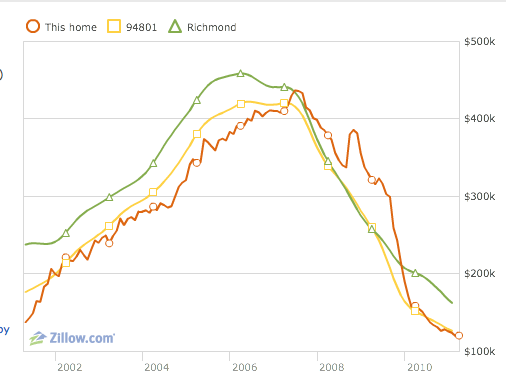I have been looking for evidence of what mortgages do to housing prices in the United States, which is not easy since mortgages are so widespread they effect almost all houses. Finding an example to compare how much our houses would cost if we just did not have our mortgage system is therefore not easy. But I think I have found one: Atchison Village in Richmond, California. This housing development is absolutely amazing for many reasons, but for now I will just focus on this one aspect.
Atchison Village is former defense housing made up of 450 housing units. The whole village was purchased from the Department of Defense as a single parcel in 1956, financed with a mortgage that was paid off 20 years later (and the residents had a party and a mortgage burning). The residents “own” their houses, but can not get mortgages from Bank of America and the like because Bank of America can not then resell the mortgages to Fannie Mae. Therefore the houses cost between $30,000 and $70,000 according to wikipedia, but my investigations found they currently go for a bit above $70,000. The reason they go for that much, we were told, was that was what the local credit union would lend a resident to help them pay for the unit. It is not quite a mortgage, as there is no lien on the property. It is more like an credit card loan– it is tied to the person. (Interestingly they have had very few defaults in the 50 years of making these loans).
Therefore the price of these houses are based on what you can borrow to buy them. This is an interesting result.
Houses just outside the gates of Atchison Village sold for between $400,000 and $500,000 during the housing bubble and they the neighborhoods are considered by many to be dangerous and worse.
Houses outside of Richmond did not get any better from 2002 to 2007, this had always been a dangerous and undesirable location. What did change was what commercial banks would lend on a house because of the change in rules that Fannie Mae would accept for income to support the mortgage.
Therefore, it appears that houses will change their price based on what mortgages are available. If interest rates go down, and therefore mortgage payments should drop, it seems that housing prices rise so that the mortgage payments stay the same. Further, if people are permitted to dedicate more of their monthly income to mortgage, then, they housing prices will rise to assume that this is what is available. Housing prices then would be correlated with interest rates and mortgage rules. And this is what we saw during the 1990’s and 2000’s in the United States.
Since Atchison Village residents were denied commercial bank mortgages, then the house prices did not fluctuate anywhere near as much. Further, the underlying price of the house was kept at a fraction of the houses in the same neighborhood.
Mortgages can make comparable or inferior houses cost 500% more than ones at the same time and same neighborhood. This is an important result. This disproves many of the assumptions of prices just being a factor of the market. It really is a matter of policy of a poorly regulated government-guaranteed for-profit entity, Fannie Mae, and its risk-avoiding for-profit partners, the commercial banks.
Therefore prices are set based on the availability of mortgages and the monthly payment not based on worth of the house. As interest rates go up, then prices will fall, and the tax payers of the United States will pay the price as they fall because we back Fannie Mae when disaster hits. But when interest rates fall once again, then it will be others that make the profit as home prices once again rise. Since there are so much money tied up in housing debt and this game is now well known and can be counted on, there are many standing to win the next time.
Monthly mortgage payments are the important factor then. This does not seem very different from rent, in many ways, from a resident’s point of view, especially when the most common length of a mortgage, 30 years, is substantially above the average of 6 years that people stay in a house. Some estimate the that mortgages are renegotiated less than every 3 years on average, so that means that most people are, in effect, always in debt and paying monthly payments. A funny story on the lack of people paying off their homes was published by National Public Radio.
We now have an example of the price we are paying for our current mortgage system– much higher housing prices, tax payer bailouts, and perpetual debt payments.
So should we have mortgages on our homes? If we want to encourage owners, that are not in perpetual debt, then we should not have the current system of mortgages. We can do better. Lets. More on that in another post.


Praise freaking Jesus! Somebody gets it!